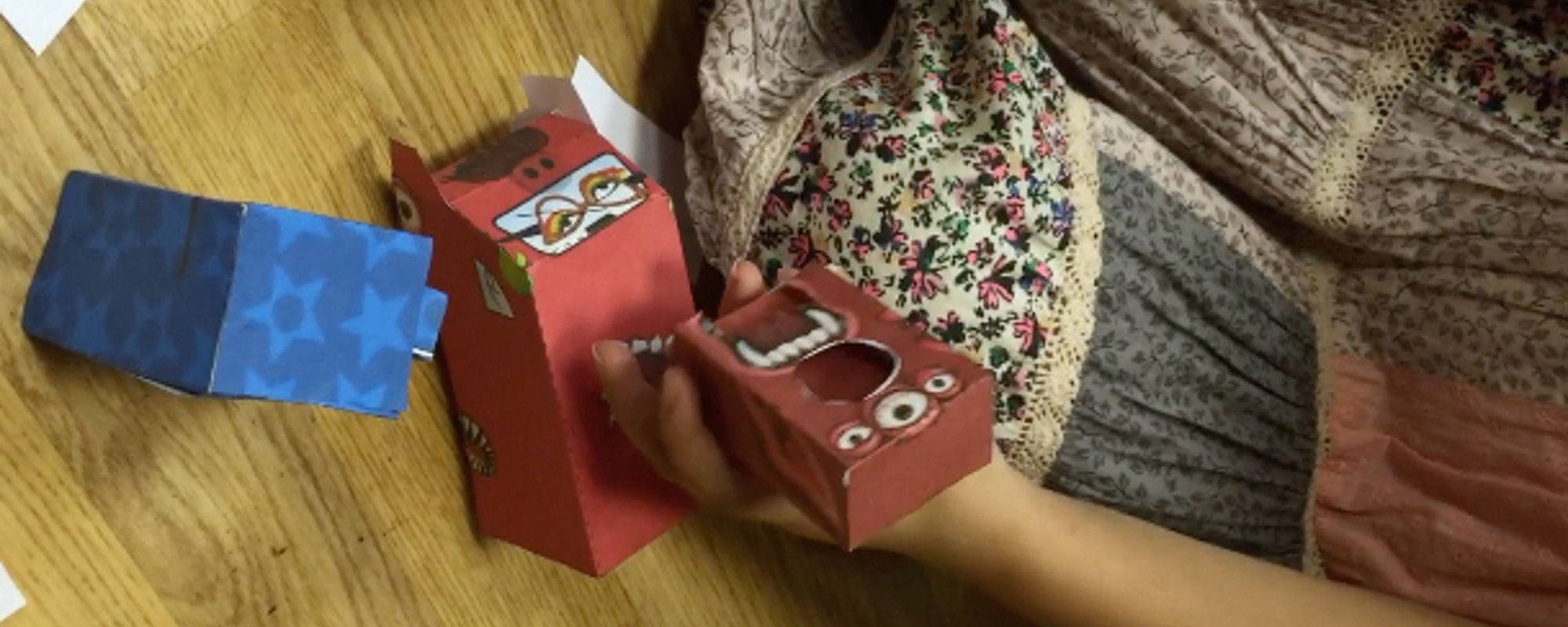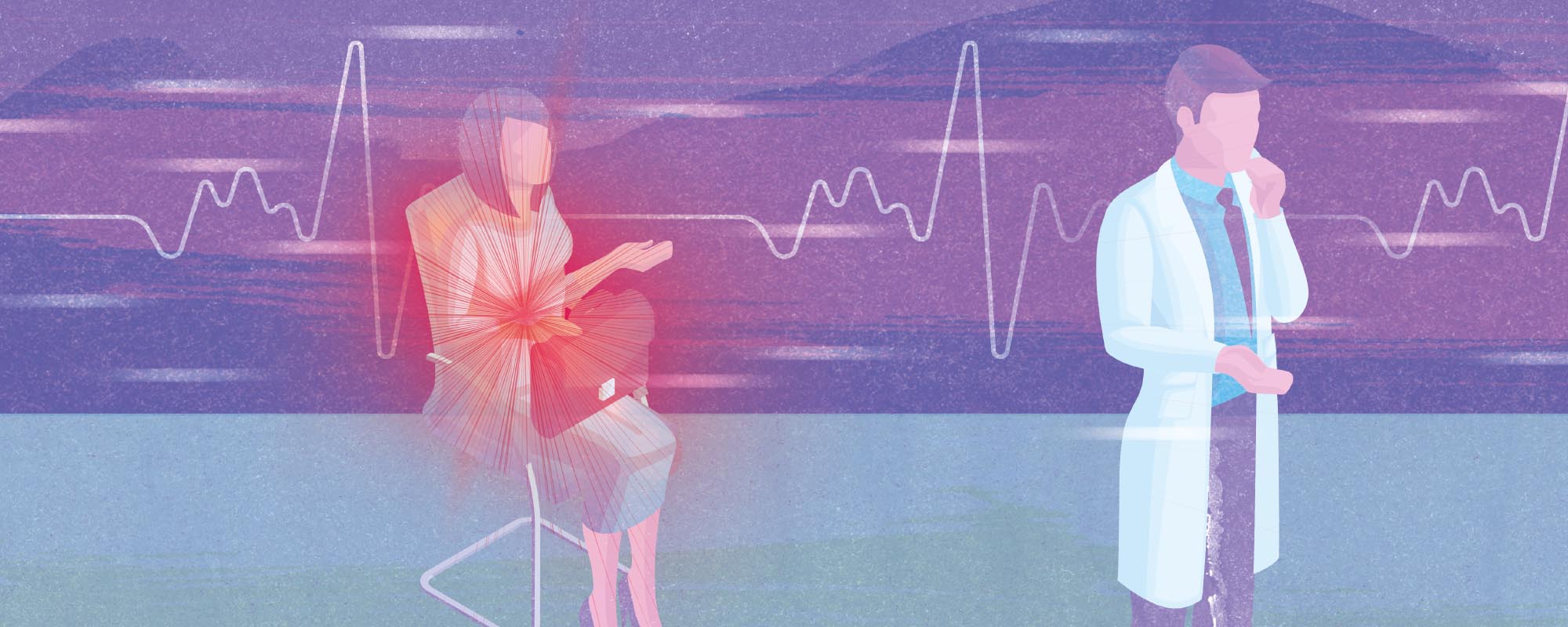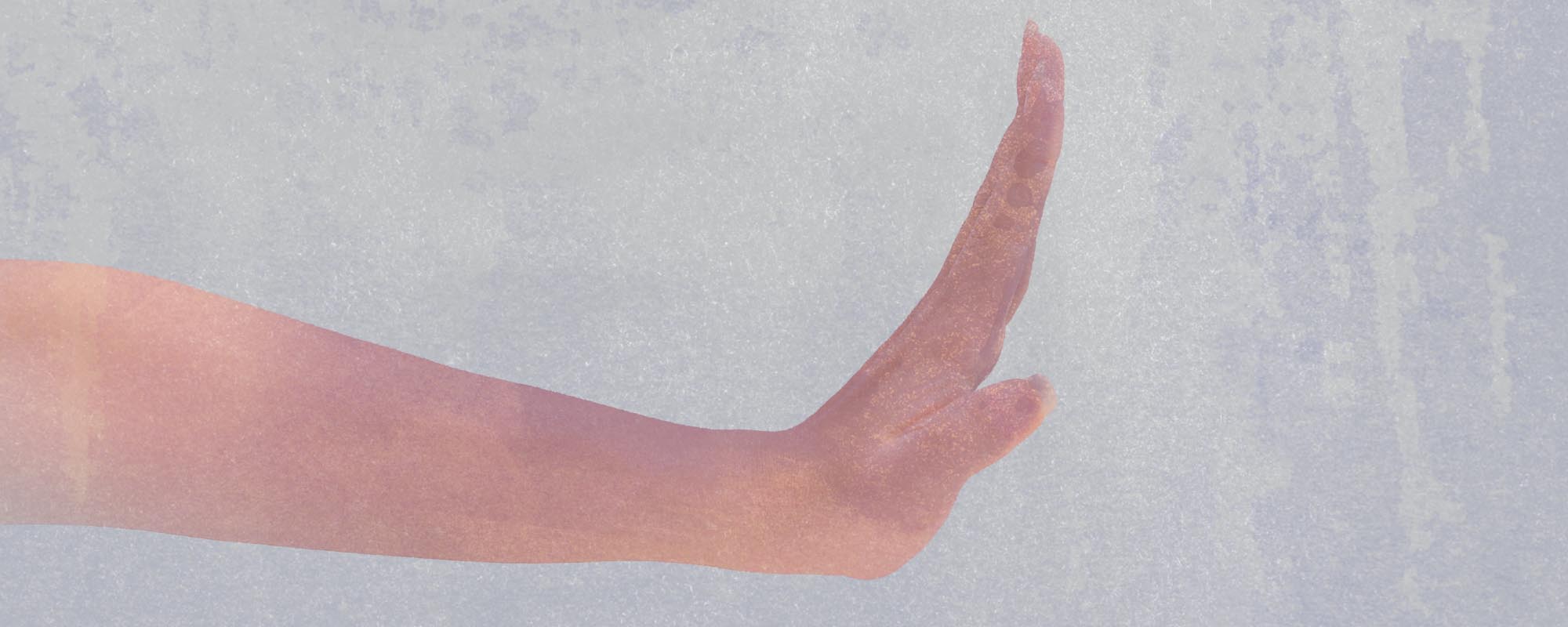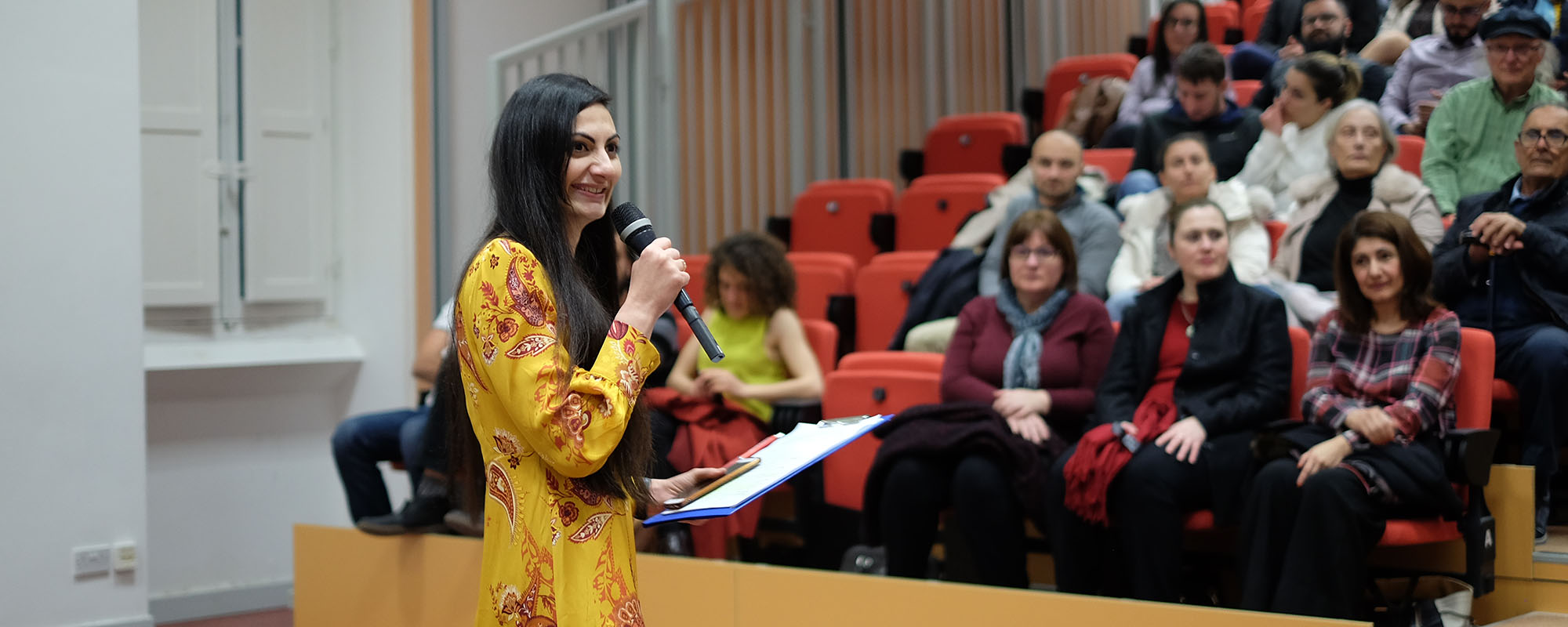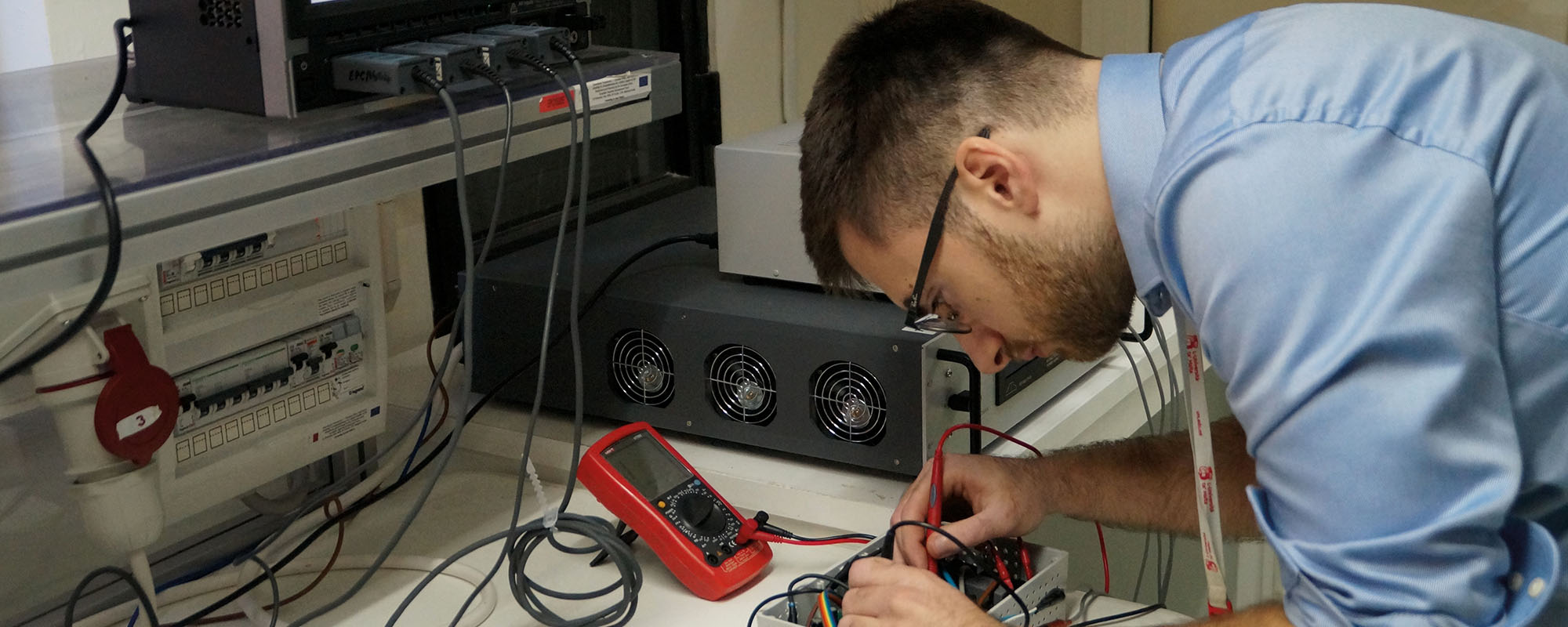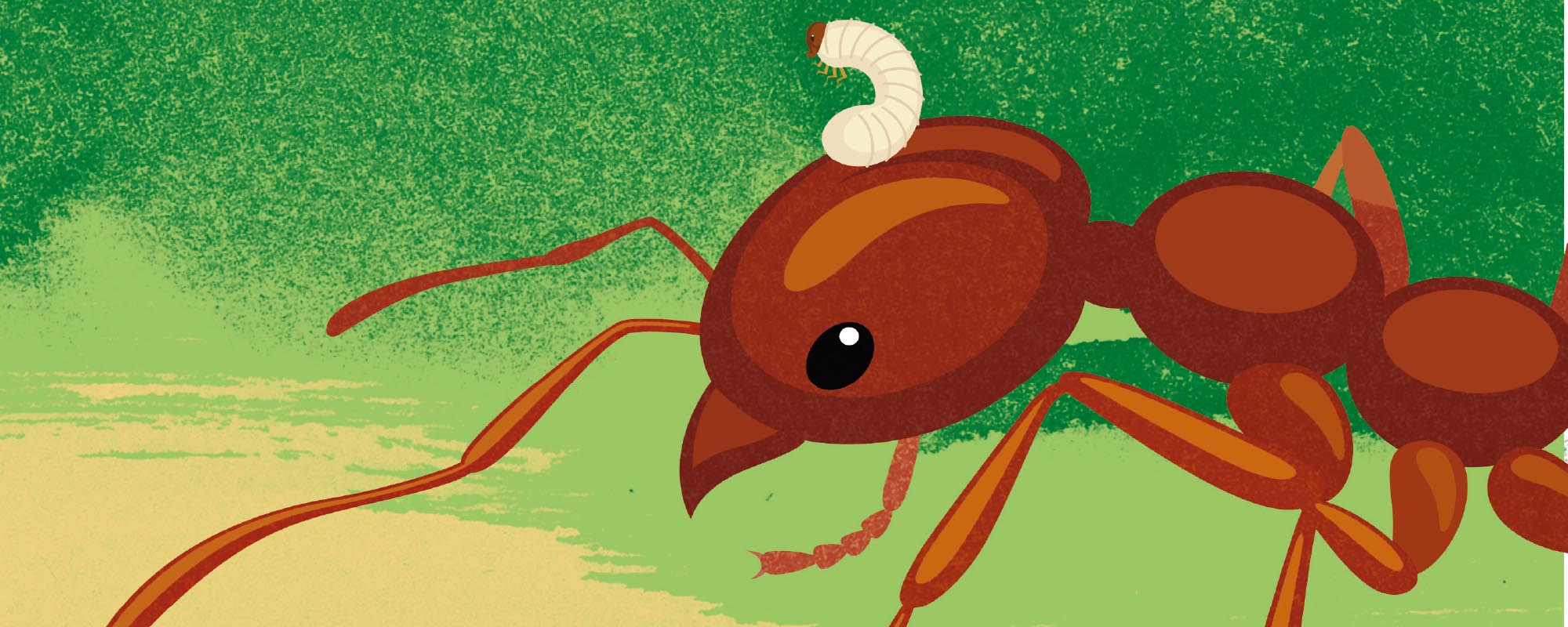Making children’s voices count
Don’t judge too soon when children enjoy various online tools, says researcher Dr Velislava Hillman — and brings data to prove it.
Continue readingDelicious delivery for your muscles
It is challenging enough to keep a workout routine, let alone cook nutritious, varied meals at the same time. What if sporty people could have unique meals delivered to their door? Marija Camilleri meets a team that fills this business niche and fitness enthusiasts’ stomachs.
Continue readingOne size fits… male?
‘Man-flu’ memes and the celebration of women’s endurance hide the reality that the medical world routinely downplays women’s pain and disease. Miriam Calleja takes a closer look.
We often hear that women are more tolerant to pain than men. Many are also proud of it. However, in the famous game-changing paper titled ‘The Girl Who Cried Pain: A Bias Against Women In The Treatment Of Pain’ the authors Diane E. Hoffman and Anita J. Tarzian found that contrary to popular belief, women report more severe levels of pain, more frequent pain, and pain that lasts longer than men’s. Three Maltese women found out the hard way that confiding in medical practitioners does not always lead to help.
Culture and gender frame our behaviour around pain perception. Boys were, and some still are, told not to express pain by crying or showing emotion. Girls were told to calm down and not make a fuss. Pain meant weakness. Our language lacks the vocabulary to adequately describe pain. In ‘On Being Ill’, Virginia Woolf writes: ‘English which can express the thoughts of Hamlet and the tragedy of Lear, has no words for the shiver and the headache… The merest schoolgirl, when she falls in love, has Shakespeare and Keats to speak for her; but let the sufferer try to describe a pain in his head to a doctor and language at once runs dry.’
Gendering pain
By analysing a number of studies, Hoffman and Tarzian found that women are ‘more likely to be treated less aggressively in their initial encounters with the healthcare system until they prove that they are as sick as male patients.’ This is a phenomenon known as the Yentl Syndrome. In other words, doctors may brush female pain off as fabricated or exaggerated. This can impact diagnosis, disease progression, and treatment plans — delaying care and fueling mistrust.
Prescribing uterus removal when a woman was ‘rebellious’ may seem like ancient history, but that bias has not fully retreated. Until the early 1990s, women were mostly excluded from clinical research studies and trials in medicine. What we knew about the body, about disease, and about medicine was based on men. Drugs that didn’t work on men, but might have worked on women, were discarded. With incomplete data, the medical world may have lost opportunities to improve women’s health. Have today’s healthcare professionals been trained to counter this gender bias?
Another doctor later referred Karen for an MRI, and the tumour was detected — a life or death analysis.
Antonia* doubts that. As a teenager she developed digestion problems and nausea every time she ate. When she complained, her family doctor downplayed the problem and suggested that she should just stop eating for a couple weeks. After this shocking response she ignored the issue for a long time, suffering in silence. Another doctor chalked it down to ‘growing pains’ and did not recommend a colonoscopy, even though Antonia asked for it.
Having received no satisfying response from her visits to medical professions, Antonia decided to do her own research, discovering that her symptoms matched the description of a condition called Crohn’s. Because of her constant discomfort and pain Antonia had no choice but to persist until she was granted testing and the correct treatment after years of suffering. This means that two doctors would have left her inflamed digestive system untreated, risking further damage.
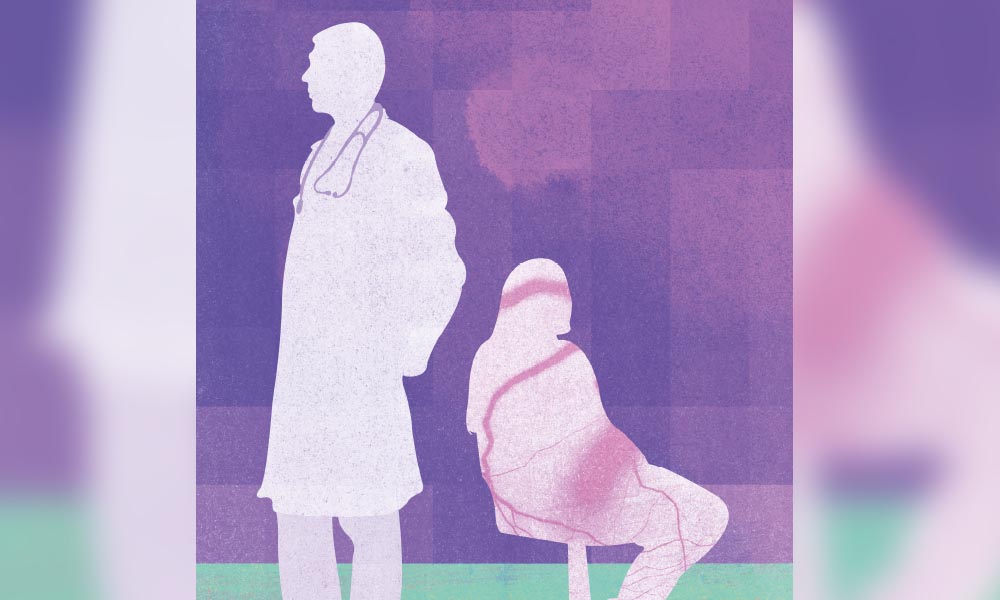
‘It is just a phase’
Women are often told that their ailments are due to stress or other emotional factors. A little rest would solve the problem; it is just a ‘phase’. Some doctors would call a woman insisting on referral for further testing a hypochondriac, even in the presence of positive clinical tests (see e.g. Samulowitz et al. 2018 study and numerous articles in the New York Times, The Atlantic and elsewhere). Thankfully, there are enough doctors who look beyond textbook-like symptoms. They make it a point to listen and investigate as much as necessary. Yet the burden of finding a practitioner ready to listen lies with the patient.
Karen visited her gynaecologist complaining of headaches and substantial weight gain. Test results revealed a high prolactin level, which is normally produced during pregnancy or right after giving birth. Yet when Karen asked to be referred for an MRI to investigate for tumours in the pituitary gland, the doctor refused, telling her that she was ‘making a fuss’. Another doctor later referred Karen for an MRI, and the tumour was detected — a life or death analysis.
Some doctors would call a woman insisting on referral for further testing a hypochondriac, even in the presence of positive clinical tests.
Gynaecologists feature often when discussing gender bias. Without systematic training to counter biases, women are left to ‘shop around’ for a gynae that doesn’t shame them or belittle their wishes. This is surprising for a profession specialising in women’s health.
Reproductive issues open another can of worms. Some women who decide not to have children are treated as though they don’t know what they’re doing. Their doctors imply that the patient will inevitably change their mind, or try to guilt the patient into considering the feelings of a hypothetical man they might meet.
You would think that commitment to bear biological children would be respected, but women who undergo IVF are often treated with insensitivity too. Sandra* and her husband had a harrowing story to tell me. Sandra’s gynaecologist decided to immediately hurry her to IVF after the first visit about their concerns at not being able to conceive. The gynaecologist was rarely present for her many appointments at hospital, leaving Sandra to be passed from one doctor to another, internally examined by various doctors without explanation or prior request for consent. With the exception of one doctor, none of them introduced themselves. All along she tried to ask questions, but was kept in the dark about the situation, going along with the doctors’ instructions but losing trust. The outcome of the first procedure was unsuccessful, and because of how traumatising all this felt, the couple decided not to try again.
Unlearning the bias
Pain is subjective and difficult to measure. An individual’s tolerance to pain is affected by various factors, and pain perception may change with time and experience. Pain causes distress, which makes it difficult to measure objectively. So how can overworked doctors make the best possible assessment?
In her thesis titled ‘The Chronic Pain Management Service: Awareness and Perceptions Among Healthcare Professionals’ (University of Malta, 2008), Maria Campbell studied pain perception in other healthcare professions in Malta back in 2008, finding out that outdated attitudes have not been challenged. She writes, ‘Incomplete knowledge, outdated attitudes, myths, and misconceptions about pain and its management contribute to unsafe, inadequate, and inappropriate pain management.’ Medical practitioners wanted to be more up-to-date: ‘The need for information in the form of leaflets, seminars, and continuing education was echoed in the overall answers (90%) of the close-ended question and in the statements declared by participants.’ But before this training becomes systemic, the radical act of listening to women is a good place to start.
* Name has been changed
Further reading:
Fassler, J. ‘How Doctors Take Women’s Pain Less Seriously’. The Atlantic. October 2015.
Hoffman D.E., Tarzian, A.J. ‘The Girl Who Cried Pain: A Bias Against Women In The Treatment Of Pain’. Journal of Law, Medicine & Ethics, Vol. 29, pp. 13-27, 2001.
Campbell, M. ‘The Chronic Pain Management Service: Awareness and Perceptions Among Healthcare Professionals.’ University of Malta. June 2008.
#MeTooSTEM: We must do more to protect women
You can have all the role models in the world. You can enjoy grants and empowerment seminars. Yet when a senior colleague you’ve always looked up to corners you, all you want is to run away, fast. Cassi Camilleri writes.
The heightened awareness around equality and representation has reached Science, Technology, Engineering, and Mathematics (STEM) fields. The global effort to recruit more women and girls into industries traditionally described as male-dominated is yielding results. In 2017, women outnumbered men in the Psychology, Pharmaceutical Science, and Biology undergraduate programmes at the University of Malta (UM). However, increasing the numbers of women is paving the way to a whole new, and yet despairingly old, battle. Many who brave becoming a minority in their profession report having to face numerous barriers. Sexual harassment is one of them.
Jennifer (not her real name) had big dreams when she first entered the field, and continues to uphold them, but it has not been easy. She didn’t see red flags in the ‘friendliness’ of a new project colleague, until he crossed boundaries. ‘I had a colleague who was much more established than I am, and every now and then he would make throwaway sexual comments. This was all supposedly in the spirit of “joking around”. But I think when you have a position of authority, you have to be even more careful about the comments you make. Your subordinates are not really in a position to make their discomfort known,’ she says. Reporting this behaviour is difficult in closely knit teams, like innovative startups, laboratories, or teams sharing grant funding.
Sexual Harassment Isolates
Jennifer felt all alone in this, but sexual harassment in the workplace is a known issue in Malta. According to research conducted by the NGOs Men Against Violence and the Women’s Rights Foundation, three out of every four female respondents reported experiences of sexual harassment in the workplace.
‘Many of respondents to our survey who had reported instances of sexual harassment said that they were silenced in some way, usually by being ignored, not taken seriously, but sometimes they were even demoted or threatened with dismissal,’ says Aleksander Dimitrijevic, founder and president of Men Against Violence. Internationally, the movement to expose STEM-specific patterns of sexual harassment became known as #MeTooSTEM. In 2018, the US’s National Academies of Sciences, Engineering, and Medicine (NASEM) published a damning report titled Sexual Harassment of Women: Climate, Culture, and Consequences in Academic Sciences, Engineering, and Medicine. The research showed that ‘[w]omen in STEM endure the highest rate of sexual harassment of any profession outside of the military.’ It also stated that ‘[n]early 50% of women in science, and 58% of women in academia, report experiencing sexual harassment, including 43% of female STEM graduate students.’
I think when you have a position of authority, you have to be even more careful about the comments you make. Your subordinates are not really in a position to make their discomfort known.
‘When my colleague found out that I was in a relationship with another woman, he started making comments about how attractive my partner was and how she couldn’t possibly be gay. As a member of the LGBTQ+ community, I found this very jarring,’ Jennifer tells. Just how many young women share her experience is not known, as local research is sparse, and looking for stories on social media was challenging because each unique testimony risks exposing the survivor.
The fight against sexual harassment needs institutional structures in place to handle such cases. The UM has been at the forefront of this since the early 1990s, according to Dr Maureen Cole (Faculty for Social Wellbeing), an advisor appointed to support the UM’s efforts to quash sexual harassment and help victims achieve resolution. ‘Thanks to the efforts of the Gender Issues Committee, the University of Malta has had a sexual harassment policy in place since 1994,’ she explains, noting that this preceded national legislation. ‘There were times when one of the [local] banks looked to us for guidance and advice in the late 90s. It was, and is, a clear commitment from the Rectorate to make sure people are protected. The University should be given some recognition for this. I feel that it is important to recognise good practice,’ Cole asserts. This openness is notable, as messages to human resources staff at other relevant institutions were left unanswered.
Are people like Jennifer using these services? Cole reports that the number of sexual harassment reports made at the UM per year average between one and two in an institution with 11,500 students and nearly 1,600 members of staff (latest published data). Cole admits, ‘It is a low number.’

Communities of silence
The fearful climate poisons the work environment. ‘It made me feel like it was no longer a professional environment, and it was isolating. I had to politely laugh off the comments because I didn’t want to damage a professional relationship I knew was important to my career. The sad thing is I know I’m not the only one, and it makes me feel guilty not speaking up when I hear there are others,’ says Jennifer.
Academia’s hierarchical structures lend themselves easily to abuse of power. The NASEM report revealed that ‘90% of women who report sexual misconduct experience retaliation.’ Malta’s small size and hugely connected networks makes this even more of a threat to those considering speaking up. Cole highlights this point in her lectures. ‘I say to my students, imagine if I were the harasser. I’m teaching you here at University. There were times when I was on the social work profession board. So you’re coming to apply for a warrant, and I’m sitting on the same board. I’m an advisor to this person and that person. You can’t get rid of me. Because Malta is what it is. […] If you’re a lawyer, you’re going to be encountering these people. […] If you’re a medic, you’re going to be in the same hospital. I’m not saying people shouldn’t report, but I understand why they don’t.’
The sad thing is I know I’m not the only one, and it makes me feel guilty not speaking up when I hear there are others
‘On this occasion, the reports and comments made against my colleague were acknowledged by my team when I brought them forward, but it was difficult. I knew that I would still have to work closely with this person,’ says Jennifer. ‘Communities at this level are tiny and people bump into each other all the time. My network and my prospects could have suffered significantly if my other colleagues did not receive the complaints as well as they did. And I’m grateful for that.’ Finding a safe space feels more urgent than seeking justice. Sending an anonymous message to the popular Women for Women group feels more urgent than describing very personal encounters in a formal report.
The current reality is that when a report comes to the Sexual Harassment Advisors, anonymity cannot be afforded for very long. ‘We cannot investigate [a complaint] without seeing the other person’s side of the story according to the regulations,’ says Dr Gottfried Catania, also a sexual harassment advisor at the UM. ‘The other side has to be made aware of the accusation, Cole continues. ‘There will be a point where the accused will receive a report saying this person is making this report about your behaviour. And many times, even people who come very determined to take action do not go forward once they realise that.’
Speak up Malta
Dr Lara Dimitrijevic (Department of Gender Studies) has a lot to say about the shame surrounding sexual harassment, not only in STEM but in Malta as a whole. ‘We have a culture of dissuading people, silencing people. Malta has a very high percentage of the population that believe that women make up stories. I find this very shocking.’ According to data from the research quoted earlier, a third of all respondents believed that victims of sexual harassment were partly to blame due to the way they dressed or behaved. Victim-blaming is clearly still pervasive. ‘The reporting for sexual harassment to the National Commission for the Promotion of Equality has decreased from three cases in 2015, to zero in 2016, to zero in 2017, to just one in 2018. Does this mean sexual harassment isn’t happening in Malta? No. Of course not. It’s that people are not speaking out. While awareness is increasing, we feed into the victim blaming and we’re not addressing that at all.’
‘The only way to deal with sexual harassment at [the] workplace is for [a] company to take [a] pro-active approach: create policies and [a] clear reporting system, inform every new employee on their first day about it, have [the] policy printed and hanged on the walls of the offices, have HR department organise training, Aleksander Dimitrijevic suggests.
Innovation binds all STEM disciplines. Without fresh minds, innovation stops. We stop creating new solutions for the problems our societies continue to face. We owe it ourselves, to our communities, and to those taking the helm, to provide safe spaces and break the silence.
What does sexual harassment look like?
According to the Code of Practice compiled by the Maltese National Commission for the Promotion of Equality for Men and Women (NCPE), sexual harassment at the workplace is defined as ‘unwelcome sexual conduct’ and is unlawful under the Equality for Men and Women Act, 2003 (Cap 456) and under The Employment and Industrial Relations Act, 2002 (Cap 452).
Sexual harassment may take many different forms and can involve:
- unwelcome physical contact such as touching, hugging, or kissing;
- staring or leering; suggestive comments or jokes;
- unwanted invitations to go out on dates or requests for sexual interaction;
- intrusive questions about an employee’s private life or body; unnecessary familiarity;
- insults or taunts based on your sex;
- sexually explicit emails or messages;
- sexually explicit pictures, screen savers or posters;
- behaviour which would also be an offence under the criminal law, such as physical sexual assault, indecent exposure, and obscene or pornographic communications.
Sexual harassment procedures at UM
The procedures to deal with sexual harassment at UM start when the sexual harassment advisors meet the person reporting sexual harassment to listen to their account of the incident/s. From here, the advisors provide information on other support services available at the university and nationally, and offer referrals as needed.
The next stage is making a decision about the action to take. The informal route involves a written agreement signed by the complainant and the alleged harasser as a form of assurance that the behaviour is not repeated. The formal route involves a report being made to the police and potential disciplinary action being taken.
STEMming gender gaps
In an equal society, men and women would be drawn to various careers in roughly similar numbers. The fact that there are still so few women in the Science, Technology, Engineering, and Mathematics (STEM) fields shows that something is crooked in the recruitment and retention of students and staff. Danielle Martine Farrugia writes.
As a young girl, I was always curious to understand the world around me, constantly asking questions and conducting mini-experiments. The world was my oyster — nothing was off limits. A pivotal moment was when the 12-year-old me chose to profile the accomplished scientist Marie Sklodowska Curie for a school project. A physicist, chemist, wife, mother, and the only person to receive two Nobel prizes — in Physics and in Chemistry — she is the best-known female researcher who jumped through hoops to be given the same opportunities as male colleagues.
I began to understand the trepidation she overcame to further her education. I saw how she surpassed obstacles in a male-dominated environment. At this point in my life I was not aware of what women had to endure to move forward and conduct scientific research. However, by reading up on and speaking to female researchers and scientists, I realised that reality was far from balanced. Running Malta Cafè Scientifique, our team committed to finding at least one female speaker each year, but even that was difficult, as women are not that visible in research. The experience motivated me to have a panel discussion on the gender gap in STEM at a Malta Cafè Scientifique event.
The European Commission defines the gender gap as a disparity between men and women in any social, political, or cultural area, which results from different participation levels, access, rights, and remuneration. Studies cited by The Conversation revealed that journal editors are less likely to commission work from female scientists. When applying for postdoctoral fellowships, women received ‘lower competence ratings than men who had less than half their publication impact’. In the words of Malala Yousafzai, the Pakistani activist for female education and the youngest Nobel Prize laureate, ‘We cannot all succeed when half of us are held back.’
Our team committed to finding at least one female speaker each year, but even that was difficult, as women are not that visible in research.
There are no grounds for different participation levels in STEM. In Malta, girls score significantly higher than boys in science, according to the international PISA (Programme for International Student Assessment) survey of 15-year-olds, measuring their skills in reading, science, and mathematics. Despite women’s good exam results, four out of five graduates in computing and engineering are male across the EU (as of 2012). This trend is consistent worldwide, especially at the University of Malta (UM), where student undergrad statistics from 2018/2019 show that STEM graduates are overwhelmingly male-dominated (engineering — 85% and ICT — 86%), except for health sciences (76% female), dental surgery (64% female), and medicine and surgery (60% female).
‘Research shows this has a lot to do with social belonging and the belief in one’s [chances to] succeed. This means that in order to attract more girls to study STEM subjects and enter STEM careers, we need to address the stereotypes they are exposed to, and we need to do this as early as possible,’ says Irene Mangion, Programme Developer at Esplora Interactive Science Centre. UM psychology graduate Gillianne Saliba explored this gap in Malta in her undergraduate study, ‘Women in STEM: A qualitative study on women’s experiences’. She found that female undergraduates pursued STEM courses when they were exposed to STEM subjects early on and when they found a structure to support them.
Building on these principles, the Ministry of Education initiated Teeny Tiny Science Café and the National Science STEM expo at Esplora, engaging Malta’s main higher education institutions. ‘Engaging women in STEM outside of the formal academic structure is essentially democratising women’s voices within the community,’ believes Simone Cutajar, chairperson of GreenHouse, a local citizen science NGO. Through such experiences, citizens are given the opportunity to see whether they would like to pursue science as a career.
Defining career moments should not depend on individual luck.
Supportive mentors and role models, male or female, are crucial. Dr Claudia Borg from the Faculty of ICT (UM) considers herself lucky to have found men who believed in her capabilities and supported her in the advancement of her studies and career. But defining career moments should not depend on individual luck. To structure the access to mentors, the ‘Women in Science — Bridging the Gap’ project is building a mentorship structure to offer female role models to students.
‘From an early age, our education system informs our upcoming generations about male scientists,’ the project’s manager Karen Fiorini believes. ‘Their achievements are hailed as admirable, life changing events, which is great. Unfortunately, however, the failure to mention female scientists’ accomplishments is stripping children of female role models.’ Run by the Malta Chamber of Scientists and funded by the Voluntary Organisations Project Scheme of the MaltaCVS, a national council of nonprofits, this scheme will reach out to children aged 6–11, sixth formers, and adults. Using interactive performances and interesting activities, the project’s team will bring Maltese female researchers and their work to the fore.
In the words of Malala Yousafzai, the Pakistani activist for female education and the youngest Nobel Prize laureate, ‘We cannot all succeed when half of us are held back.’
So far we have covered recruitment and mentoring. But why do established, competent women leave STEM careers in droves? We need more Malta-focused research to understand this complex issue. By awarding the Equality Mark to organisations that prioritise gender equality, the National Commission for the Promotion of Equality is encouraging tech companies to create a safe space for both genders to work harmoniously side by side. Tech professionals are rising to the challenge. Vanessa Vella, a Senior Software Engineer working as a full-stack web developer at CS Technologies, co-founded and co-chaired an NGO called MissInTech to introduce more women to technology.
All these local changemakers are working hard to reform recruitment, career development, and staff retention. Is that enough? We invited some of them to discuss this at the Malta Café Scientifique event ‘Women in STEM,’ supported by Pro-Rector for Student & Staff Affairs and Outreach Prof. Carmen Sammut. Inspired by my younger self and that simple school project, the Malta Café Scientifique team is drafting a set of recommendations for institutions following the panel discussion. STEM fields cannot afford to continue bleeding talented women.
Further reading:
Fine, I. and Shen, A. ‘Perish not publish? New study quantifies the lack of female authors in scientific journals.’ The Conversation, 8 March 2018.
How linguistics helped me power up my language
‘If you are a woman working in a traditionally male hierarchy, you have one of two choices: Quit or Masculinize’. Linguist Prof. Lydia Sciriha chose to end her keynote speech at the HUMS symposium with this quote from Pease and Pease (1999). As a curious scientist and keen observer of society, she has accumulated a plethora of personal stories to show how communication gaps solidify gender inequality. She shares them here with Daiva Repeckaite.
Continue readingLet’s rethink our motors
From washing machines and vacuum cleaners to air conditioners and fans, household appliances all contain electrical motors, and we tend to take them for granted. However, appliances’ high starting currents can disrupt electricity supply and shut down a whole house. Daniel Lendi unpacks some of the hard work needed to fix this problem.
Continue readingWomen’s baroque male allies
In early modern Malta, some men resisted patriarchal attitudes which oppressed women. Drawing upon two cases lifted from primary sources, Dr Christine Muscat argues that written history has largely neglected the voices of men who manoeuvred patriarchal structures to empower women.
Continue readingFor the love of ants
The relationships between ants and other organisms can be just as complex as the subterranean networks they tunnel. Thomas Cassar takes a closer look at how these insects farm, steal, and co-habit.
Some ants’ tendency to ‘farm’ aphids (plant sap-sucking insects) for their sweet honeydew is decades-old knowledge. Cynics use this phenomenon to downplay the achievements of humans: look, an animal the size of a sesame seed had mastered agriculture long before human beings.
But aphids aren’t alone in this world of ant-coexistence. There’s a specialised group of animals which ignore the opinion of disgruntled roommates worldwide, seeking out the company of others. These are the myrmecophiles, literally ‘ant-lovers’. Such a phrase may conjure up an image of a great expert, maybe someone like the American biologist E. O. Wilson, pouring over an anthill (that would be a myrmecologist). Myrmecophile is an organism that just can’t live without ants.
The Ant Nest Ecosystem
Ants’ nests are prime real estate for the enterprising and the brave. If you can somehow get on good terms with your ant hostesses, you’re guaranteed a temperature-regulated shelter free of predators. And if there’s one thing all living things agree upon, it’s that you don’t say ‘no’ to a free bed and meal. But there’s always an adaptive fee to pay.

There are chambers for the brood, guards, the queen, and for food storage. The nest’s surroundings can yield rich pickings, too — the foraging routes, for instance. But if you’re tiny, good at holding on for dear life, or look like a nightmare straight out of Ridley Scott’s Alien, then the bodies of ants can be your home.
Many mites — tiny arachnids — feed on ants as parasites. The highly specialised mite Macrocheles rettenmeyeri just can’t resist a sip of army ant blood, and to get its meal it latches onto the ant’s last foot segment. But army ants can’t do their job with a bad foot; they form protective clusters by hooking each other’s claws together. So the mite earns its keep by converting its whole body into an extra ant’s foot. When the ant needs to use its claws as gripping hooks, the mite’s legs bend to serve the same purpose.
Antennophorus mites are another kind of ‘considerate’ parasite. Taking up positions on either side of the ant’s head or abdomen, they create a balanced load. Although it would be better for the ant if these thieves of regurgitated food weren’t there at all, this balancing act somewhat reduces the problem.
Patting someone’s head for a snack might not be recommended in human society, but for ants, sharing regurgitated food after a few antennae-taps is a way to communicate and strengthen social bonds among nest-mates. It’s also nutrition on tap for intruders who know how to say the magic word. So apart from lapping up food as it is passed from one ant to another, Antennophorus stroke the ant’s antennae with their legs in a way which mimics the touch signals from other ants requesting food — and hey presto, the host presents a globule of food, glorious food.
The trails of foraging ants can also offer an easy meal. One species which takes advantage is the Amphotis beetle. It waits for ants heavily laden with food, and like a highwayman of the undergrowth, gets the ant to regurgitate food by drumming on its head with its antennae.
Antennophorus stroke the ant’s antennae with their legs in a way which mimics the touch signals from other ants requesting food — and hey presto, the host presents a globule of food, glorious food.
The myrmecophile VIPs have adapted to gain exclusive access to the most precious confines of any nest: the brood chamber. Here, ants tend to their larvae day and night, guarding them fiercely, and feeding them generously. To live a luxurious life here, you need to get under the radar. The ingenious larvae of beetles have learnt to not only mimic the food-begging behavior of the ants’ own larvae, but they mask their intrusive presence by releasing a pheromone which triggers brood-tending behaviour. The beetle has mastered these mechanisms so well that its larvae end up getting a bigger helping of food than the young ants themselves.
You scratch my thorax, and I’ll scratch yours
Many myrmecophilous relationships are truly reciprocal. Some caterpillars of blue butterflies (Lycaenidae) seek out ants’ care and protection in exchange for a concentrated sugar solution secreted by a gland on their back. In some treehopper species, which exchange honeydew for protection, females abandon their young early on to the care of their farmers, being able to produce more clutches of eggs in the meantime.
The benefits of reciprocity can be so great that they may change the way ants live their lives and build their nests. Malaysian herdsmen ants (Dolichoderus cuspidatus) have no permanent nests, instead constructing shelters out of their own living bodies to protect their livestock — honeydew-producing mealybugs. When the mealybugs’ plants run dry and all seems lost, the ants pull up their socks and efficiently transport the mealybugs to fresher pastures. The discovery of this behaviour in 1985 was the first known case of non-human nomadic herding.
To live a luxurious life here, you need to get under the radar.
One need not travel to far-flung forests to appreciate the world of ants. Prof. David Mifsud (Institute of Earth Systems, University of Malta) recently worked on a study which brought the total known ant species in the Maltese Islands up to 70, a world with its own cast of characters. There are clean-up crews of blind, white woodlice scavenging the nests of harvester ants. Golden nicoletiidae silverfish zoom around, feeding on debris and stealing the odd morsel of regurgitated food and getting away with it, because the silverfish have learned to copy their hosts’ nest’s unique identifying odour. A sub-endemic, 4mm-long cricket (Myrmecophilus baronii) lives with carpenter ants, its wings lost in the course of evolution, along with much of its eyesight. A ground beetle (Siagona europaea) uses the secretions of its ant prey to make itself less detectable as it hunts.
From an ant’s perspective, living with other insects rather than eating them may ensure that precious resources are always in stock — much the same reason why humans went from hunter-gatherers to farmers. For the myrmecophile, there is one good reason amongst many for moving in with ants. By providing the ants with a useful resource, you avoid becoming their breakfast, lunch, or dinner. If you can’t beat them, join them.
Further reading:
Mifsud D. & Lapeva-Gjonova, A. (2019). ‘Additions to the ant fauna (Hymenoptera: Formicidae) of the Maltese Islands.’ ARPHA Conference Abstracts 2: e46475.
Talarico, F., Bonacci, T., Brandmayr, P., Dalpozzo, R., De Nino, A., Giglio, A., Tagarelli, A. & Zetto Brandmayr, T. (2009). ’Avoiding ant detection in Siagona europaea Dejean 1826 (Coleoptera Carabidae): an evolutionary step towards true myrmecophily.’ Ethology Ecology & Evolution, 21(1), 45–61. doi: 10.1080/08927014.2009.9522510.
Von Beeren, C., Schulz, S., Hashim, R., & Witte, V. (2011). ’Acquisition of chemical recognition cues facilitates integration into ant societies.’ BMC Ecology, 11(1), 30. doi: 10.1186/1472-6785-11-30.


